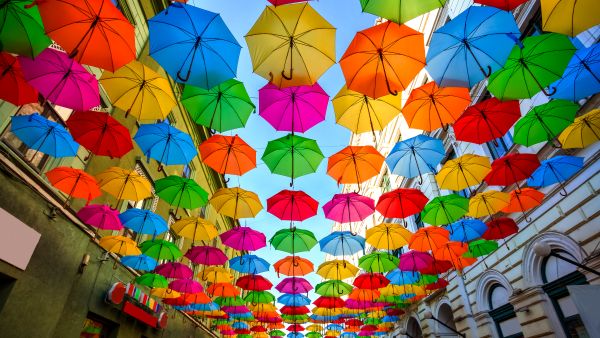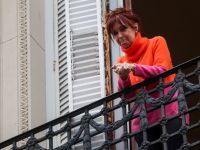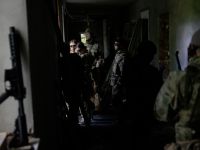The entire world has experienced some degree of trauma in the last year, as the coronavirus pandemic has killed more than 2.5 million people and caused untold suffering due to lockdowns and economic damage.
Meanwhile, the suffering of those trapped in war and conflict, natural disasters and other crises has not stopped. As people around the world seek ways to cope with collective and individual trauma, art offers one way to process the pain.
New Aga Khan Museum exhibition combines art and science to tell COVID-19 story through ‘Dance of the Molecules’ https://t.co/QoEEnM4ymK
— Toronto Star (@TorontoStar) March 11, 2021
Art therapy is sometimes recommended for individuals who have experienced personal trauma. On a broader, societal level, art also offers ways to cope with widespread trauma. Professional artists play a key role in helping societies express collective experiences, while individuals can use art to cope with their own and their community’s suffering.
Stolen Palestinian art at display in tel Aviv art museum as ancient israel ?????????✌? pic.twitter.com/CrfRZrGcAc
— علاء الدين قاسم اليسيني?????? (@alaqasem1980) October 16, 2020
Around the world, artists have played a role in expressing the complicated feelings of living through a pandemic, but using art to help manage terrible experiences is not new. Syrians, Palestinians, refugees, military veterans, Holocaust survivors, domestic violence survivors and many others have used art to communicate their experiences and to process their feelings. While their experiences are not all directly comparable, art has provided many of them with a tool to cope.
My art and article on the first anniversary of the COVID-19 lockdown in the Philippines is now available on the latest (physical) issue of the Philippine Daily Inquirer ? #artph pic.twitter.com/ZuRbEWypAr
— luna • moon ? ia bc final exam szn (@themoonmadeart) March 12, 2021
Art provides a way to communicate trauma to the artist’s own society and the wider world. People who have experienced extreme trauma often find it difficult to express what they have endured through words. Art can help them to express emotions that can feel unspeakable or inexpressible, such as despair, hopelessness, grief, fury, alienation, loss, fear and exhaustion, as well as more positive emotions such as hope and love.
Often, these emotions are deeply tied up together and art can help express that complexity. Some experiences, such as the Holocaust, are so extreme that survivors often struggle to communicate their experiences in ways that audiences might understand, but art can play a role in helping to bridge that gap. When words and data fail to foster empathy, visual arts can be an effective tool for making a connection with others.
Art by: @shiwani315
— Tales of a Modern Buhari (@modernbuhari) March 17, 2021
How many of you all felt the heaviness of your bridal Lehenga and your gold jwelery during the peak of covid 19 lockdown.
Being a buhari working from home isn’t as easy! We did a whole discussion on this! pic.twitter.com/UU6NORJRfN
Art is also important to remembrance. For communities that have lost their homelands and their way of life, it provides a way to hold onto their heritage. And for those who have lost loved ones and neighbors, art can help survivors remember and cherish them. Remembering the trauma, the suffering and the resilience of people who died and survived is essential to long-term recovery for communities and individuals.
"The Ides of March are come".
— William Gropper Art (@gropperart) March 15, 2021
Winter is winding down and, fingers crossed, so is Covid. @artnet @MuseumModernArt @whitneymuseum @robertasmithnyt @culturemonster @QueensMuseum @MilwaukeeArt @LACMA @WSJarts pic.twitter.com/icIJAf6WrZ
For some communities, art provides a means of protecting identities that are under threat. For example, traditional forms of art, such as embroidery, and modern forms of art, such as photography and mixed media, play a role in asserting Palestinian identity and demonstrating that Palestinian traditions, history and experiences exist and have value.
Art also plays a role in demands for justice or peace.
In case it needs to be explained:
Stop using Brown/Black trauma for your art, stop reducing MENA to war and conflict, stop separating Palestine from Palestinian art/poetry/suffering - and if someone from the background you are disrespecting asks you to take it down? Do it https://t.co/h1HUKhFneX— Jed ? - فلسطين حرة ?? (@stellaminervaa) March 14, 2021
Walls, such as the one that divided Berlin in Soviet times and the wall Israel has erected in the West Bank, offer huge canvases for many types of artists, including those who highlight injustice and call for political change. In the US, the racial justice movement that has gained momentum in the last year has prompted many murals and examples of street art. In Belfast, Catholic and Protestant communities use murals to assert their political narratives.
Keith Haring’s art being turned into a brand / cheap logo for profit feels super disrespectful and overshadows a lot of his other more political works that covered things like the AIDS crisis, the war on drugs, queer love, safe sex, and a lot more. pic.twitter.com/nsOyZirQOS
— ⭑ fin ⭑ (@cryptidspells) March 1, 2021
In crises like the pandemic, public works of art can help communicate important messages. For example, in several parts of the world, artists have created murals, sculptures and other artwork encouraging the wearing of face masks, social distancing and gratitude for health workers.
War and peace both need art funding | Brief letters https://t.co/Cqj5H8CHyS
— Guardian Opinion (@guardianopinion) March 12, 2021
Art is an important means for processing trauma. Art therapy is sometimes advised for individuals, particularly traumatized children, who often lack the vocabulary or ability to discuss their feelings through words. Similarly, art can help communities process collective trauma. As with individuals, art can help communities tell their story, which is critical to recovery. Art allows a way to communicate so that individuals feel less alone. In some cases, such as with refugees, art can help people to reclaim a sense of personal and community empowerment.
One advantage to art is the multiple media artists can use, which allow them to connect to various audiences. A variety of media is also useful for artists who lack access to traditional materials, as they can work with materials that are locally available and that often enhance the originality of their works. Furthermore, art allows for both concrete representations, such as drawings of Syrian prisoners (see Syrian artist Azza Abo Rebieh), and abstract representations, such as arranging blister packs and photography to evoke urban landscapes (see Palestinian artist Mahmoud Al-Haj).
'The bed and the white pillow became my new home' Etching by Syrian artist Azza Abo Rebieh to be understood in the the context of her release from prison in Damascus and exile from Syria. In a @meiartsculture exhibit for #Syria10 h/t @jomanaqaddour cc @donmonet pic.twitter.com/IPrUPTZBvx
— Juliet O'Neill (@JulietONeill) March 15, 2021
#Syria: Azza Abo Rebieh & Sima
— mazouneh (@MizoMazouneh) March 10, 2021
Two women, ten years on.
Ten years ago, protesters in Syria began calling for freedom. #Assad clamped down, with ever increasing violence.
Hundreds of thousands have died, and millions have been forced to leave the country.https://t.co/6ZzhnjGZyp
In a world of uncertainty, conflict and displacement, art can transcend traditional institutions. While galleries and museums play a critical role in supporting artists and allowing audiences to view art, artists who lack access to such institutions find innovative ways to express themselves, including graffiti, murals, and using online exhibits and social media.
The older I get, the more appealing it sounds to become a hermit with my animals and live off the land. No conflict, no heart ache, just art and vibes. pic.twitter.com/XupIDjDYyx
— Juliana Corona (@julianascorona) March 14, 2021
Art plays a particularly important role in expressing the experiences of communities that have suffered trauma and in calling for justice. Furthermore, in a time of global trauma and uncertainty, art provides a way to form connections, despite social distancing, and to express the complex, varied experiences of the pandemic.
Kerry Boyd Anderson is a writer and political risk consultant with more than 16 years' experience as a professional analyst of international security issues and Middle East political and business risk. Her previous positions include deputy director for advisory with Oxford Analytica and managing editor of Arms Control Today. Twitter: @KBAresearch








